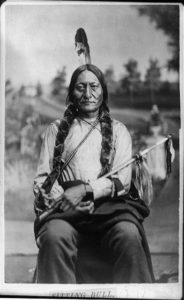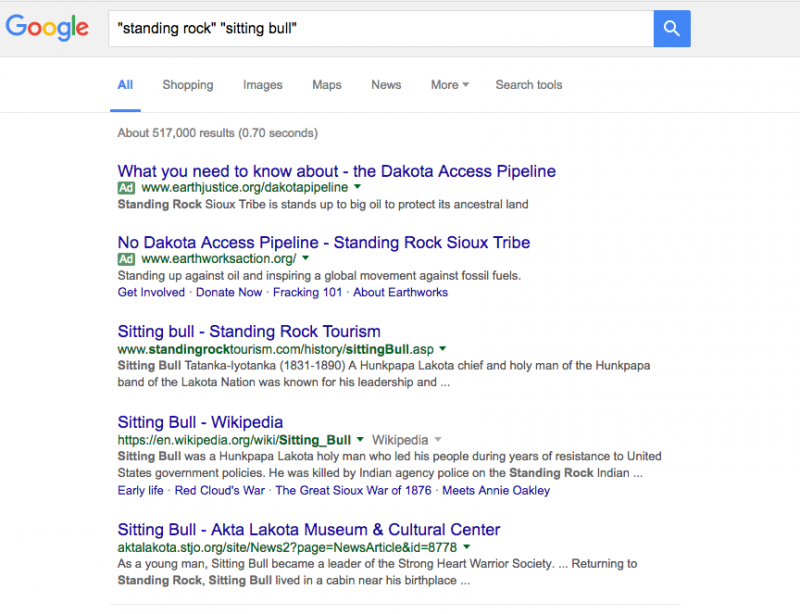This was originally posted on the National Council on Public History’s blog, History@Work

As I’ve watched the groundswell of protest at the Standing Rock reservation in North Dakota over the building of a new pipeline carrying “fracked” oil from the massive Bakken oilfield, I’ve been surprised by the lack of mention of what seems to me to be one of the most striking things about this action: the fact that it’s taking place on the same reservation where Sitting Bull was killed in December 1890 by federal Indian agency police who came to arrest him as part of an attempt to suppress a wave of Indian resistance.
The story of the day after Sitting Bull’s death is better-known. At another reservation to the south, as many as 300 people, including some who had fled from Standing Rock, were killed by federal soldiers near Wounded Knee Creek. Sometimes referred to as a battle but more often as a massacre, the event has been a touchstone for indigenous resistance ever since, including in a 1973 occupation of the town of Wounded Knee by activists from the American Indian Movement.
There’s an incredible resonance here with today’s civil disobedience actions at Standing Rock. A very broad alliance of indigenous groups and non-indigenous allies and environmentalists has taken a stand against the building of the Dakota Access Pipeline, but also against the expansion of extractive processes and infrastructure on indigenous lands more generally. As with other pipeline and anti-fracking protests, they’re warning about specific problems like potential spills and pollution of water sources. But they’re also talking about the overall moral relationship of humans to our environments as well as making very broad statements about sovereignty and stewardship. It’s this broader message that seems to be sparking such wide solidarity and support.
It is not, however, garnering as much media attention as you might expect at this point. In fact, journalists are being very actively discouraged from covering the story, including through arrest and threats of arrest (a warrant was recently issued for independent broadcaster Amy Goodman on the charge of trespass and “riot,” based on the argument that she was sympathetic to the protesters and was therefore a protester herself).

But even in the limited coverage that’s finding its way into the press, I’ve been struck by how absent any discussion of history is. Maybe the historical connections with Sitting Bull’s death and Wounded Knee are so completely obvious to indigenous people that they feel no need to mention them except in passing or between the lines. That’s the approach taken by Standing Rock Sioux chairman David Archambault II in an op ed piece for the New York Times and by Winona LaDuke in an article for Yes!Magazine ( although this piece on White Wolf Pack blog states the connection more directly).
In general, there’s virtually nothing in the press about Sitting Bull, let alone explanations that might suggest how inspiring–and also how alarming–the knowledge of the past must be for the activists who are now preparing to dig in to this deeply resonant place for the winter. If you do a Google search for “Sitting Bull” and “Standing Rock,” you have to click through several pages of hits before you get to sources that could help you piece together anything like the fuller story of broken treaties, violent repression, determined resistance, and forced relocations that underlie today’s protests.
When I polled the students in one of my classes at Tufts University about this last week, only a few were vaguely aware of the Standing Rock actions, something that surprised me given their general attentiveness to questions of social, racial, and environmental justice. Most had heard of Sitting Bull and a couple knew about Wounded Knee. I’m glad that some faculty and students at my institution are holding a teach-in about Standing Rock that’s connecting some of these dots. But there’s clearly much more that could be done–perhaps including by public historians–to get the message out not only about what’s going on in the present but about how it emerges from a long, painful, and very specific history of contestation in this part of what is now the United States.
~ Cathy Stanton is a senior lecturer in anthropology at Tufts University and an active public historian. She serves as digital media editor for the National Council on Public History.
The opinions expressed by guest contributors to the Maryland Humanities blog do not necessarily reflect the position or policy of Maryland Humanities and/or any of its sponsors, partners, or funders. No official endorsement by any of these institutions should be inferred.

